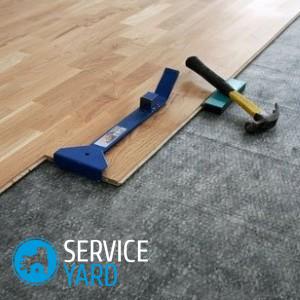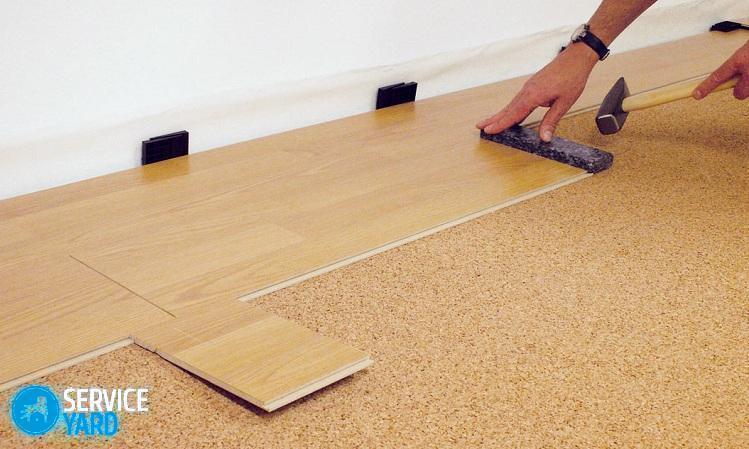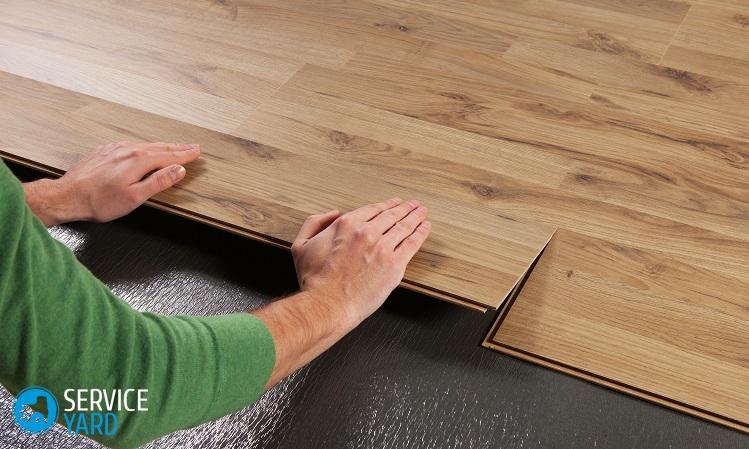How to lay a laminate?

Laminate is a popular floor covering today, which is characterized by ease of installation and high performance. The process of laying a laminate involves preparing the base, laying a layer of insulating material and directly laying the coating. In order to understand how to properly lay a laminate, a number of extremely important nuances should be studied. Let's get it together.
to contents ↑Prerequisites for laying the laminate
Laminate is a rather capricious option for flooring, if it comes to its installation:
- The temperature in the room should be constant or, at least, without strong changes (the optimal range is considered to be 15-30 degrees), and humidity should not be higher than 70 percent.
Important! Observe these conditions so that the coating does not deform.
- Also, during the installation process, it is not recommended to allow the presence of drafts or to turn on heating devices.
- The maximum allowable height difference for the base on which the laminate will be laid is 2 mm per meter. If the floor is more uneven, then it is necessary to level it. This process is different for each gender option.
Important! If you lay the laminate on an uneven floor, this will lead to its premature failure - try to avoid this.
- In addition, it is impossible to lay the coating on top of the electric underfloor heating system. This can lead to drying out and deformation of the panels. But if you really need a heating system under the floor, you can use the hydraulic option. The hydraulic system of underfloor heating will evenly distribute heat and will not overheat the coating.
to contents ↑Important! It must be remembered that there must be a distance of at least 3 cm between the elements of the heating system and the lower boundary of the laminate.
Materials and Tools
The process of independent proper laying of the laminate is quite simple: an insulating layer is laid on a pre-aligned base, on which the laminate panels are mounted on top.
Important! If laying on a concrete base, an additional waterproofing layer may be required.
For installation you will need the following:
- Laminate.
- Primer for removing uneven floors.
- Construction glue, if you plan to carry out glue laying.
- Foamed polyethylene or another type of substrate.
- Skirting boards, as well as fixtures for them.
- Wedges for creating clearance gaps.
Important! If you are going to lay laminate flooring with minimal financial costs, you can use pieces of drywall or wooden pegs as spacers to create deformation gaps.
In addition to the above materials, you will also need a set of the following tools:
- Tape measure and building corner.
- Marker or pencil.
- Jigsaw, hacksaw or construction knife.
- Wooden block.
- Hammer.
to contents ↑Important! After all of the above is prepared, the laminate must be put for several days in the room where it will be laid.This is done so that the humidity and temperature of the materials come in line with the same indicators in the room, otherwise, deformation of the panels is possible.
Laminate floor leveling
Most likely, many have the question whether it is possible to lay a laminate with their own hands on an uneven floor. This can only be done if the height differences are not more than 2 mm per meter. In the event that the difference is greater, the laminate panels may poorly dock or deform during further operation.
Important! Furniture that will be installed on an uneven floor may stagger, and the doors may not close, which will cause inconvenience.
So, the primary task of laying the laminate on an uneven floor will be its alignment. For each of the types of base base there is a special way:
- It is advisable to prime the newly installed cement screed using special building mixtures. For these purposes, Ceresit-17 or Ceresit-15 can act.
Important! This primer can not only level the base, but will not give it dust, will prevent unpleasant creaking of the floor under the laminate.
- If you want to learn how to level floors without screed, then this is possible if you use a sand-cement mixture. With its help, the concrete floor is leveled, cracks and grooves are poured. For better alignment, all holes in the basecoat should be expanded. In the event that the irregularities are too large, a special self-leveling mixture can be used, which needs to be ground after hardening.
- To lay the laminate on an uneven floor from wooden boards, it is necessary to disassemble the old coating, eliminating and replacing all failed parts. Also align with plywood sheets.
Important! Please note that this method will significantly raise the floor level. Therefore, with a small ceiling height, this method is undesirable.
- If the basis of the floor is a coating of plywood or boards, frivolous irregularities can simply be cut with a grinder. Before doing this, be sure to deepen the fastener caps.
to contents ↑Important! After the base of the floor for laying the laminate becomes smooth, you can begin mounting the substrate.
Laminate flooring
A backing is a must if you use floating technology to lay laminate flooring.
Important! There are models of laminate with an already glued backing to the panels. Laying such a coating is much faster and easier than other types, but it costs more.
Background Functions
The substrate under the laminate is necessary in order to ensure the following qualities:
- Moisture insulation - the basis of any type of laminate is pressed paper, which means that the coating is sensitive to moisture, due to which the panels can swell and deform. It is especially important to make a waterproofing layer if you lay the laminate on top of a concrete floor.
- Soundproofing - if you do not lay the substrate, a wooden or concrete coating under the laminate can creak unpleasantly.
- Thermal insulation - the substrate layer prevents the cold from the cement or concrete floor to affect the temperature of the laminate. If you use a system of underfloor heating and wonder what to put under the laminate so that the quality of heating does not decrease, there are special options for substrates that conduct heat well.
- Aligning minor defects - remember that the substrate can mask only minor irregularities. To eliminate more serious changes in height, there are the above methods.
Types of Substrate
There are several popular types of substrates, each of which has its own advantages and disadvantages.
Cork panels:
- Environmentally friendly and health friendly. They are made from pressed oak bark.
- The cork perfectly conceals minor defects, boasts a high level of heat and noise insulation, as well as a long service life.
Important! Of the minuses of such a substrate, it can be distinguished that it does not tolerate moisture and is quite expensive.
Polyethylene foam:
- It is very easy to operate, and it also very well resists aggressive chemicals, and fungi and bacteria do not multiply on its surface.
- Another advantage of this material is its increased moisture resistance, so it is recommended to make such a substrate in rooms with a high level of humidity.
- In addition, polyethylene foam is quite light.
Important! There are also disadvantages - this is fragility. It quickly loses its shape and working properties, so you need to be prepared for the fact that such a substrate will often need to be changed.
Expanded polystyrene
The optimal version of the substrate, which combines a relatively low price, durability and good performance:
- it responds well to the system of warm floors;
- easy to install;
- able to mask small defects in the base.
Important! The disadvantage of this material is that over time, panels from it can lose shape.
Pressed needles
Recently, a fairly popular type of substrate, since it passes air well, is environmentally friendly, but thicker than other options for substrates, and its price is much higher.
Important! If you decide to use coniferous plates as the substrate, then they need to be laid diagonally.
How to lay the substrate?
Before you start laying the substrate, you need to thoroughly study all the nuances, the only way you can correctly lay the laminate:
- To lay the substrate correctly under the laminate, provided a freshly installed concrete screed is installed, a thin layer of polyethylene should be put on the floor before installation.
- Any kind of base layer must be thoroughly cleaned of any debris. To do this, it is better to use a vacuum cleaner, and not a wet rag, because the base must be dry.
- The selected material can be cut using a knife or conventional scissors. In the process of calculating the dimensions of the substrate, consider the overlap on the walls, which will subsequently be covered with a baseboard.
- Do not lay multiple layers of the substrate in order to compensate for floor defects. If the selected material is not enough to make the base layer even, it means that you have poorly aligned it.
- The backing sheets should be laid end-to-end, not lapped. If you do not want the material to move during operation, you can stick it to the floor using double-sided tape.
Direct laminate laying
In principle, it does not matter how to lay the laminate with your own hands - along or across. The correct way is considered in which:
- Laying begins with the installation of the first panel in the corner of the room near the window.
- Wedges should be installed between the wall and this panel in order to form a deformation gap.
- Then the next one is attached to the first panel, and so on, until the entire row is completed.
- The second row must begin with the piece on which the first was finished.
Important! If you lay the laminate and in the process from the last panel of the first row there is a piece less than 30 cm, then to start the second row you need to use half of the new panel.
- The second row is initially stacked without connecting it to the first. Only after all the panels of the first row are connected to each other, it can be fixed along the entire length to the previous row.
Important! For greater reliability of the joint at the junction, you can attach a wooden block and gently tap on it with a hammer.
The entire floor is mounted in the same way.
to contents ↑Diagonal Laying
Diagonal laying is considered one of the most common methods for installing a laminate.
Important! In order to lay the laminate itself in this way, during the calculation of the amount of material, 7-8% should be added to the total area of the room.
Operating procedure:
- Diagonal styling starts the same way as transverse or longitudinal - from the corner near the window.
- Before you begin installation, you should stretch the fishing line from an angle at an angle of 45 degrees to the wall - subsequently the rows of coating will be aligned on it.
- With the diagonal method, the edges of the first panel are cut at an angle of 45 degrees, and wedges are mounted between the wall and it for a gap.
- Next, measure the two strips of the laminate so that the joint between them is in the middle of the first row, and the edges that are cut at an angle are near the wall.
- In the same way the entire floor is filled.
to contents ↑Important! In residential premises there are many difficult places for laying the cover, for example, doorways, heating pipes.
Laying near heating pipes
Bypassing heating pipes or other communications is one of the most difficult nuances in the process of solving the problem of how to properly lay a laminate. Here you need to listen to these recommendations:
- Proper installation should begin in the layout of the panel for the future hole.
- In order to create a hole in the laminate, it is advisable to use special drills - “ballerinas”.
- The diameter of the hole should always be slightly larger than the diameter of the pipe. So it is necessary so that the coating can “walk” under the influence of humidity and temperature extremes.
- After the necessary holes for the pipes are drilled, the panel is cut into two parts. One of them is mounted between the pipe and the rest of the floor, and the second between the communications and the wall. The pieces are fastened together using building glue.
Installation near the ledge of the walls
If the walls in the room where the installation is carried out have irregularities that correspond in shape, a cutout is made directly on the panel. With proper installation of the laminate, in the case of uneven walls, it is also necessary to make a deformation gap.
to contents ↑Important! There is a feature here with the connection of locks: the protruding edge should be cut from the bottom of the end face. Because of this, the reliability of the joint may suffer, therefore the joints must be lubricated with building glue.
Laying in large rooms
If the dimensions of the room exceed 8 by 8 meters, then in order for the floor covering not to deform, it is advisable to make expansion joints. For this, it is necessary to use special profiles that are mounted between two unconnected sections of the laminate.
The upper part of this profile is an overlay, like those used in the upper openings. This is due to floor deformation from temperature fluctuations.
to contents ↑Important! Also, such a profile is mounted on the border of various segments of the warm floor within the same room.
Skirting Installation
To properly lay the laminate on the floor, you also need to know about installing the skirting board:
- One of the main features is that it is impossible to fix the plinth to the floor or to the laminate itself - fixing should be done exclusively to the wall.
- Each of the skirting board models has its own ideal fastener option, and the instructions in its installation are attached to the product.
Important! If your walls are not perfectly smooth, then it is better to use plastic skirting boards, as they will exactly follow the contours of the wall. Wooden species are preferably used with even walls.
- Most models have special grooves in which the wires are hidden.
to contents ↑Important! Wires should not fall into the gap between the wall and the laminate, otherwise - during expansion, the coating may be deformed.
Stock footage
Having correctly laid the laminate, you will get a beautiful, inexpensive and durable floor covering, which, if properly maintained, will delight you for many years.
- How to choose a vacuum cleaner taking into account the characteristics of the house and coatings?
- What to look for when choosing a water delivery
- How to quickly create comfort at home - tips for housewives
- How to choose the perfect TV - useful tips
- What to look for when choosing blinds
- What should be running shoes?
- What useful things can you buy in a hardware store
- Iphone 11 pro max review
- Than iPhone is better than Android smartphones





